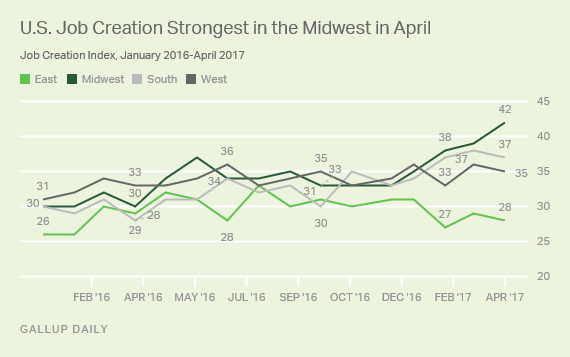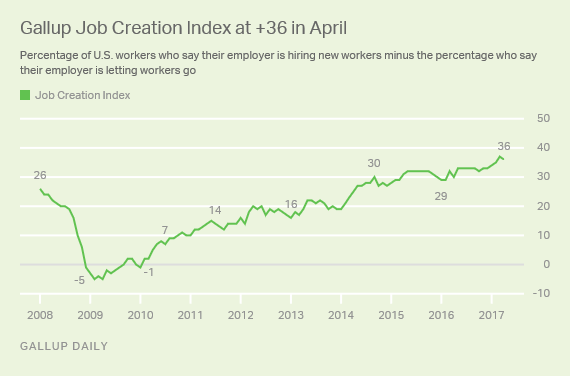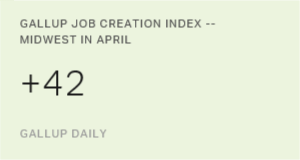Story Highlights
- Job Creation Index is at +36 in April, down from +37 in March
- Midwest region has highest job creation score
- East continues to have lowest score
WASHINGTON, D.C. -- The Gallup Job Creation Index was at +36 in April, one point off the record high of +37 in March. The Midwest led the regions at +42, the first time any region has topped +40 in the nine-year history of the index. Workers in the Midwest became increasingly likely to say their companies were hiring rather than firing in April, even as workers elsewhere reported more stagnant job creation patterns.

In the other three U.S. regions, the East, South and West, the Job Creation Index dropped one point each from March. The gap between the lowest region for job creation in the country, the East (+28), and the highest, the Midwest (+42), is now 14 points. The East has scored below the other regions since November 2016, and the gap between it and the other regions has expanded in recent months.
The reason the Midwest is doing so well may have to do with robust hiring in the manufacturing sector. Recent earnings reports from companies like 3M, Graco and Polaris Industries suggest improving business conditions in the region. Makers of nondurable goods such as processed foods in the Midwest report recent increases in hiring, and a regional economist expects continued improvement for months.
It is, however, difficult to be conclusive about why the Midwest is currently leading, or the East is lagging behind.
Job Creation Index Remains Near Record High
The Job Creation Index nationally has been on an upswing since plummeting in 2008-2009, amid the Great Recession. Since February 2010, the index has been in positive territory, and it has been at +30 or higher each month since March 2016.

The Gallup Job Creation Index is based on employed U.S. adults' reports of whether their employer is hiring workers and expanding the size of its workforce or letting people go and reducing the size of its workforce. Gallup computes the index by subtracting the percentage of those who say their employer is cutting jobs from the percentage who say their employer is adding jobs. In April, 45% of employees said their company was hiring, compared with 46% in March. Meanwhile, the percentage who said their company was letting workers go held steady at 9%. Also, 41% of workers said their employer was not changing the size of its workforce.
The Job Creation Index is a nearly real-time indicator of the nation's employment picture across all industry and business sectors. Gallup's index does not measure the type -- full time or part time -- or quality of the job gains or losses as reported by workers.
Implications
Despite slipping one point from last month to +36, the Gallup Job Creation Index is nearly at a record high. The index has been steadily climbing for years and is off to a strong start in 2017. In 2016, the index ranged between +29 and +33, so the first four months of this year are already an improvement. Employee reports of layoffs remain fixed at 9%, which is the lowest the monthly figure has been in the nine-year history of the Job Creation Index.
With the Midwest crossing into the +40 range, there is still room for the index to grow, especially if the other regions of the country catch up with the Midwest.
These data are available in Gallup Analytics.
Gallup.com reports results from these indexes in daily, weekly and monthly averages and in Gallup.com stories. Complete trend data are always available to view in the following charts:
Daily: Employment, Economic Confidence, Consumer Spending
Weekly: Employment, Economic Confidence, Job Creation, Consumer Spending
Read more about Gallup's economic measures.
View our economic release schedule.
Survey Methods
Results for this Gallup poll are based on telephone interviews conducted April 1-30, 2017, on the Gallup Daily tracking survey, with a random sample of 9,255 employed adults, aged 18 and older, living in all 50 U.S. states and the District of Columbia. For results based on the total sample of employed adults, the margin of sampling error is ±1 percentage point at the 95% confidence level. All reported margins of sampling error include computed design effects for weighting.
Each sample of national adults includes a minimum quota of 70% cellphone respondents and 30% landline respondents, with additional minimum quotas by time zone within region. Landline and cellular telephone numbers are selected using random-digit-dial methods.
Learn more about how the Gallup U.S. Daily works.




